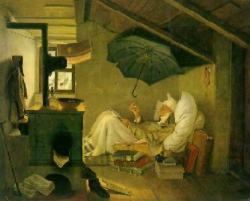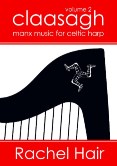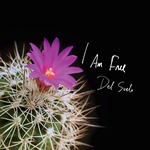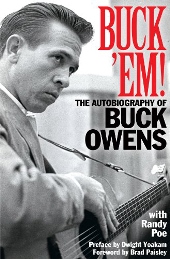
In countless interviews over the years people have asked me to define country music, muses Emmylou Harris, I just tell them to listen to Buck Owens and the Buckaroos doing 'Second Fiddle.'
 Scottish harpist and composer Rachel Hair
[61]
is a sought after harp tutor. Since 2011, she is teaching monthly in the Isle of Man
and founded the first ever Manx harp ensemble, Claasagh,
to establish the harp in the Manx tradition once again.
Claasagh Volume 2 presents twenty harp arrangements, including haunting airs and graceful waltzes as well as
stirring jigs and reels.
Many tunes were originally collected as songs without words and some have new B parts added to them by local musicians.
For example, "Arrane ny Nie" is a popular lullaby, recently recorded by Manx group
Birlinn Jiarg [61].
"Illiam y Thalhear" is a Manx version of "William Taylor's Reel", I also heard from Birlinn Jiarg as well as
German Celtic group Clarsach [45].
Guitarist Paul Cringle has written the waltz "Auldyn River,"
which became Best Original Song in a Traditional Style at the 2016 Pan Celtic Festival
with lyrics by Wendy Hurst. (Watch Rachel's version @ YouTube)
In 2014, Rachel was commissioned to write a suite to mark the 150th anniversary of
Manx art noveau artist and designer Archibald Know (1864-1933), here "Know's Jig" included.
Scottish harpist and composer Rachel Hair
[61]
is a sought after harp tutor. Since 2011, she is teaching monthly in the Isle of Man
and founded the first ever Manx harp ensemble, Claasagh,
to establish the harp in the Manx tradition once again.
Claasagh Volume 2 presents twenty harp arrangements, including haunting airs and graceful waltzes as well as
stirring jigs and reels.
Many tunes were originally collected as songs without words and some have new B parts added to them by local musicians.
For example, "Arrane ny Nie" is a popular lullaby, recently recorded by Manx group
Birlinn Jiarg [61].
"Illiam y Thalhear" is a Manx version of "William Taylor's Reel", I also heard from Birlinn Jiarg as well as
German Celtic group Clarsach [45].
Guitarist Paul Cringle has written the waltz "Auldyn River,"
which became Best Original Song in a Traditional Style at the 2016 Pan Celtic Festival
with lyrics by Wendy Hurst. (Watch Rachel's version @ YouTube)
In 2014, Rachel was commissioned to write a suite to mark the 150th anniversary of
Manx art noveau artist and designer Archibald Know (1864-1933), here "Know's Jig" included.
Rachel Hair, Claasagh Vol. 2 - Manx Music for Celtic Harp.
March Hair Publications MHP004, 2016, pp44, UK£11.00
 US singer-songwriter David Rovics [32]
has gone among the novelists. In the late 1980s, a young street musician from Boston named Casey travels to
Germany and Denmark and mingles with anarchists, squatters and refugees.
It is a story of fighting against injustice and tyranny, even if it is against all odds,
written in short and sweet prose.
A Busker's Adventures is set against the backdrop of the civil war in El Salvador;
the novel has been published as an ebook on November 22nd,
the anniversary of the leftist FMLN's military offensive.
You can get a free copy by downloading David's app from the Apple or Google stores;
an audiobook and a print run are in the pipeline.
US singer-songwriter David Rovics [32]
has gone among the novelists. In the late 1980s, a young street musician from Boston named Casey travels to
Germany and Denmark and mingles with anarchists, squatters and refugees.
It is a story of fighting against injustice and tyranny, even if it is against all odds,
written in short and sweet prose.
A Busker's Adventures is set against the backdrop of the civil war in El Salvador;
the novel has been published as an ebook on November 22nd,
the anniversary of the leftist FMLN's military offensive.
You can get a free copy by downloading David's app from the Apple or Google stores;
an audiobook and a print run are in the pipeline.
David Rovics, A Busker’s Adventures. 2016
(www.facebook.com/...)
 Canadian artist Del Suelo
has published an unusual literary-musical endeavour.
Each song correlates with one of the 10 chapters from his novel I Am Free.
Del Suelo says: „Lately I’ve been paying attention and categorizing art into two
camps: slow-art and fast-art. Fast art is something that is quickly made and is designed to get a point or sentiment
across as easily as possible.
I deliberately wanted to make an album with tons of meaning and depth, and I was able to achieve that
by adding prose.
I’m scared of how short the collective attention span is becoming, and so I hope “I Am Free” inspires folks to
slow down and take time. Plus, I’ve managed to challenge the status-quo in
the music and writing industries with the end product. I’m hella proud of that.“
Recently, Del Suolo is touring as cellist with neo bluegrass group The Dead South
[61],
reading excerpts and playing songs from the book.
Canadian artist Del Suelo
has published an unusual literary-musical endeavour.
Each song correlates with one of the 10 chapters from his novel I Am Free.
Del Suelo says: „Lately I’ve been paying attention and categorizing art into two
camps: slow-art and fast-art. Fast art is something that is quickly made and is designed to get a point or sentiment
across as easily as possible.
I deliberately wanted to make an album with tons of meaning and depth, and I was able to achieve that
by adding prose.
I’m scared of how short the collective attention span is becoming, and so I hope “I Am Free” inspires folks to
slow down and take time. Plus, I’ve managed to challenge the status-quo in
the music and writing industries with the end product. I’m hella proud of that.“
Recently, Del Suolo is touring as cellist with neo bluegrass group The Dead South
[61],
reading excerpts and playing songs from the book.
Del Suelo, I Am Free. 2016, pp112, $25 (incl. CD)

In 1937, Alvis 'Buck' Owens' (1929-2006) family left Texas for California, the land of milk and honey. The later country star received his musical education in the labor camps of Orange County, Southern California:
Buck vowed to himself, more attracted by the music than the work: When I grow up, I'm not gonna be poor any more. I'm gonna be somebody. His uncle told him that there was a pretty good music scene going on in Bakersfield with lots of clubs and honky-tonks and Dust Bowl emigrants (and Western Swing founder Bob Wills a regular in the dance halls).[56]
Buck started out as a guitar player for Bill Woods and His Orange Blossom Playboys, but soon became the band's singer.
Buck worked the clubs and studios for years. In 1959, he scored his first chart hit. One of many hits to follow. In 1963/64, his "Love's Gonna Live Here" stayed 16 weeks in a row as number one in the charts, which never happened again. In 1965, "I've Got a Tiger by the Tail" crossed over into the pop charts, and "Buckaroo" was the first instrumental that went no. 1 on the country charts. The Beatles recorded his "Act Naturally," and Ray Charles' cover of "Crying Time" won two Grammys in 1967.
The 1960's were Buck's decade: he recorded more than 60 albums, scored 21 number one country singles, and created a new kind of country music, the Bakersfield Sound, consisting of strong lead vocals, high harmonies, one or two Telecaster guitars, and an intentionally trebly mix.
Ironically, Buck Owens became country music's biggest star while breaking all the rules that the country music metropolis Nashville had laid down. According to Dwight Yoakam,[61] Buck led Fender Telecasters against cosmopolitan string sections and large choral arrangements. Buck never lived in Nashville, never recorded in Nashville, never used Nashville record producers, never worked with Nashville studio musicians, nor signed with any Nashville music publisher.
However, at the height of his career in 1969, Buck became the co-host of the country comedy TV show "Hee Haw". It made Buck Owens a household name in the US, but the more popular "Hee Haw" got, the less his records sold.
Buck needed almost two decades to recover. In 1988, Buck Owens and Dwight Yoakam hit no. 1 with "Streets of Bakersfield," at a time when the New Traditionalists dictated the sound of country music (such as Ricky Skaggs).[55]
In the meantime he had started working on his autobiography. When Buck died in 2006, he had left almost 100 hours on cassette tape, recording the story of his life with his near-photographic memory. Randy Poe (the current president of Leiber & Stoller Music Publishing) assembled all of Owens' stories and transcribed them with minimal addition and correction. Thus, Buck ‘Em - The Autobiography of Buck Owens is in his own words, an intimate conversation, which is both spinning yarns and giving a concise outlook on a crucial chapter of country music in the 20th century.
Photo Credits:
(1ff) Book/CD Covers,
(5) Buck Owens,
(6) Rachel Hair Trio,
(7) David Rovics,
(8) The Dead South
(from website/author/publishers).